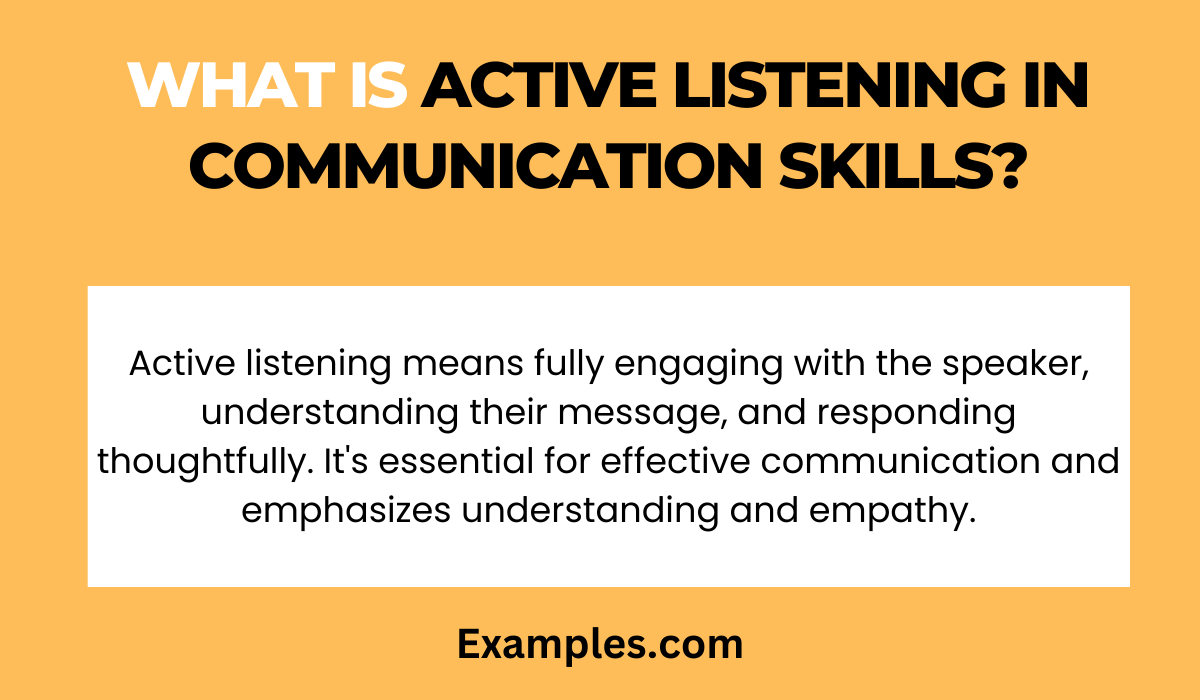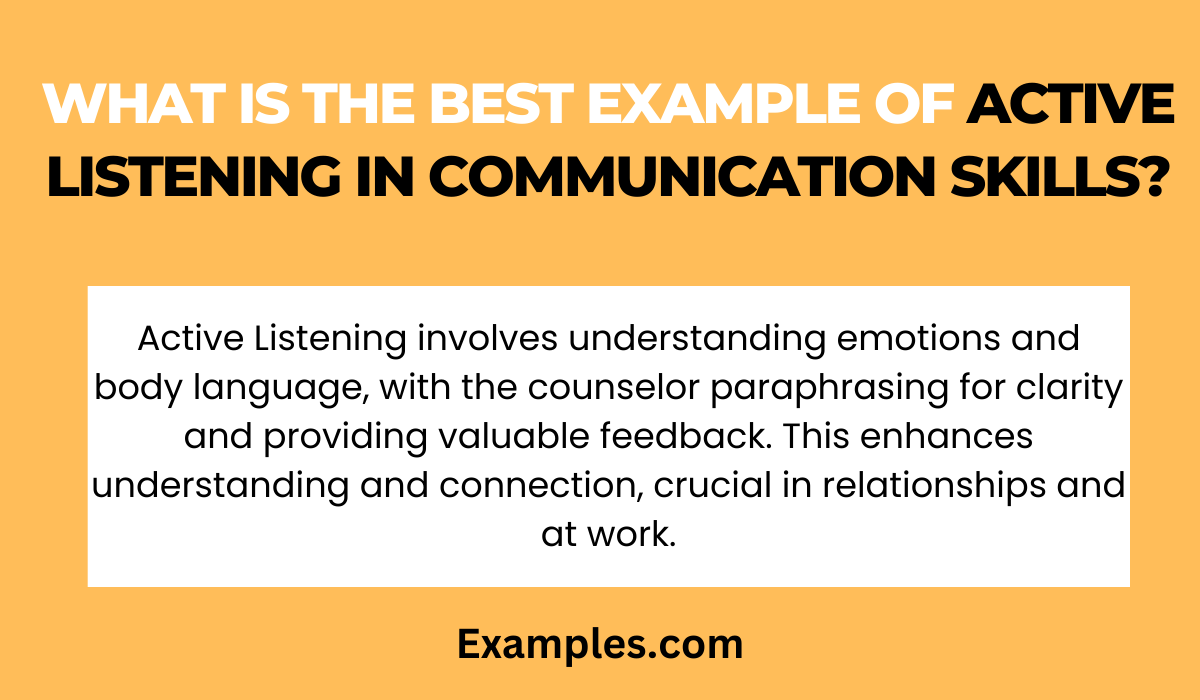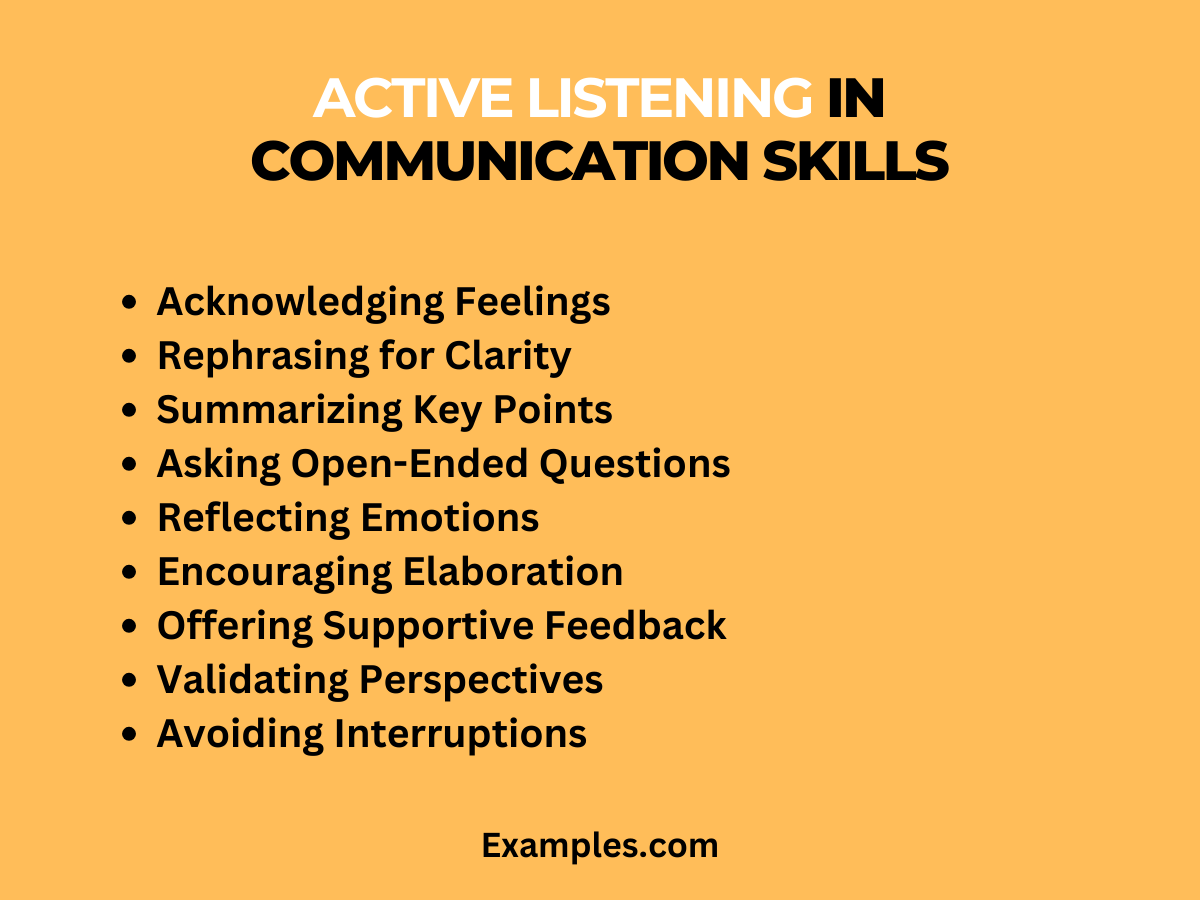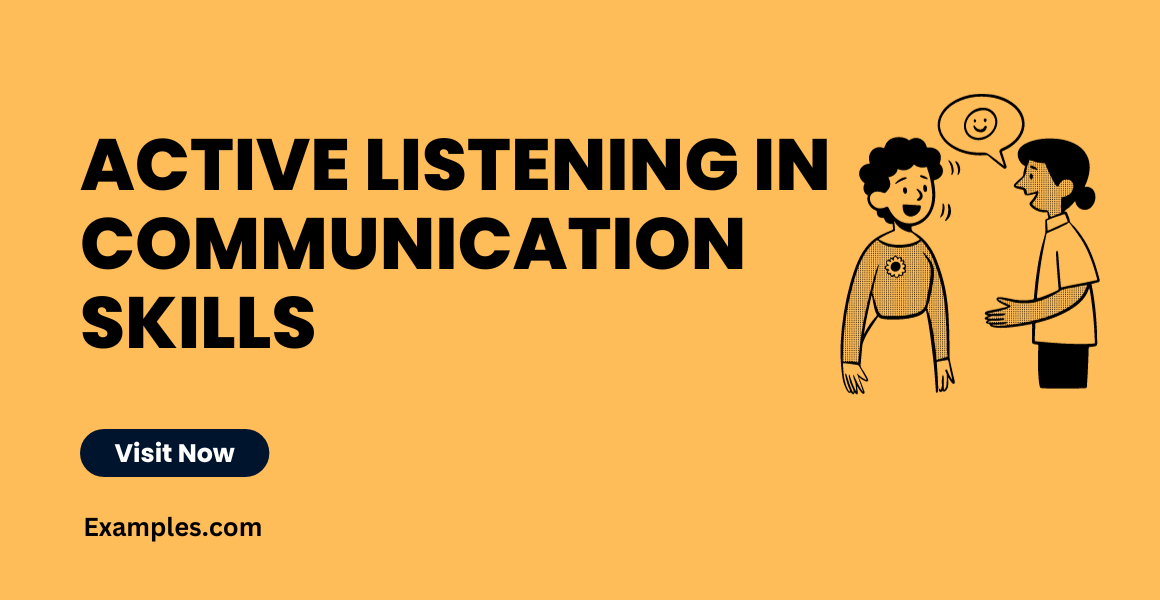29+ Active Listening in Communication Skills Examples
Active Listening in Communication Skills is a transformative skill, pivotal for enhancing personal and professional interactions. This comprehensive guide delves into the nuances of active listening, a key component of effective communication. Learn how to fully engage in conversations, interpret verbal and non-verbal cues, and respond empathetically. Incorporating practical communication examples, this guide is tailored to improve your interpersonal communication skills, ensuring you can navigate various social contexts with greater understanding and connection.
What is Active Listening in Communication Skills?
Active Listening in communication skills is a method of listening that involves giving full attention to the speaker, understanding their message, and responding thoughtfully. It’s more than just hearing words; it’s about engaging with and processing the content, tone, and emotion behind what is being said. This technique is crucial for effective communication and plays a significant role in interpersonal communication skills, where understanding and empathy are key.

What is the Best Example of Active Listening in Communication Skills?
A prime example of active listening in communication skills is seen in a counseling session. Here, the counselor not only hears the client’s words but also pays attention to their emotions and body language. They might respond by paraphrasing the client’s concerns to ensure understanding and then offering insightful feedback or questions. This scenario highlights how active listening can facilitate deeper understanding and connection, essential in communication skills in relationships and communication skills at the workplace.

30 Active Listening in Communication Skills
Active Listening in Communication Skills is an invaluable tool that enhances interactions by focusing on truly understanding and responding to the speaker. This technique, integral in effective communication and interpersonal communication skills, involves careful attention to the speaker’s words, tone, and non-verbal cues, ensuring a deep comprehension and meaningful engagement in conversations. It is especially vital in professional settings like communication skills at the workplace and personal scenarios such as communication skills in relationships.

- Acknowledging Feelings: Demonstrate empathy by recognizing the speaker’s emotions.
Example: “I can see this is really important to you. How can we address it together?” - Rephrasing for Clarity: Paraphrase the speaker’s point to confirm understanding.
Example: “So, what you’re saying is you need more support on this project?” - Summarizing Key Points: Recap the main ideas to ensure alignment.
Example: “To summarize, you’re looking for ways to improve team efficiency, correct?” - Asking Open-Ended Questions: Encourage detailed explanations and insights.
Example: “What steps do you think we should take to resolve this issue?” - Reflecting Emotions: Echo the speaker’s feelings to show understanding.
Example: “It sounds like you’re feeling overwhelmed by the workload.” - Encouraging Elaboration: Invite the speaker to provide more details.
Example: “That’s an interesting point. Can you tell me more about it?” - Offering Supportive Feedback: Provide feedback that is constructive and helpful.
Example: “Your idea has merit. Have you considered how it might be implemented?” - Validating Perspectives: Acknowledge the validity of the speaker’s viewpoint.
Example: “I understand where you’re coming from. How can we integrate this approach?” - Avoiding Interruptions: Let the speaker express themselves fully.
Example: “Please continue, I want to hear everything you have to say.” - Expressing Genuine Interest: Show true engagement in the conversation.
Example: “This topic seems crucial. Tell me more about your thoughts on it.” - Balancing Inquiry and Advocacy: Combine asking questions with sharing your perspective.
Example: “That’s a valid point. From my experience, another approach might also work. What do you think?” - Clarifying Uncertainties: Seek clarification to avoid misunderstandings.
Example: “Could you clarify what you mean by that last point?” - Using Encouraging Body Language: Employ non-verbal cues to show attentiveness.
Example: Nodding and maintaining eye contact while the speaker talks. - Following Up on Past Conversations: Reference previous discussions to show attentiveness over time.
Example: “Last time we spoke, you mentioned a concern. Has there been any progress on that?” - Demonstrating Patience: Allow pauses and silences for thought.
Example: Waiting quietly during a pause, then saying, “Take your time, I’m here to listen.” - Respecting Different Opinions: Show openness to diverse viewpoints.
Example: “I appreciate your perspective. Let’s explore how we can incorporate this.” - Giving Undivided Attention: Focus solely on the speaker without distractions.
Example: “I’m completely focused on what you’re saying. Please go on.” - Fostering a Safe Environment for Sharing: Create a space where speakers feel comfortable opening up.
Example: “Feel free to express your thoughts; this is a safe space.” - Adapting to the Speaker’s Communication Style: Adjust your listening approach to match the speaker’s style.
Example: “I notice you prefer detailed explanations, so I’ll make sure to listen accordingly.” - Noting Non-Verbal Expressions: Pay attention to what is not said verbally.
Example: Observing a speaker’s hesitation and saying, “It seems like there’s more you want to say.” - Expressing Encouragement and Positivity: Keep the conversation tone positive and encouraging.
Example: “Your input is very valuable, and I’m glad you’re sharing it with us.” - Avoiding Prejudgments and Bias: Approach each conversation with an open mind.
Example: “I want to hear your ideas without any preconceived notions.” - Emphasizing with Cultural Sensitivity: Be aware of and respect cultural differences in communication.
Example: “I’m mindful of the cultural aspects of your perspective. Please elaborate on that.” - Maintaining Confidentiality: Ensure that sensitive information remains private.
Example: “I understand this is confidential, and I respect your privacy in this matter.” - Providing Context When Necessary: Offer background information to aid understanding.
Example: “To give you context, this decision was influenced by recent changes in our policy.” - Seeking Feedback on Listening Skills: Ask for input on how effectively you’re listening.
Example: “Do you feel like I’m understanding your points? Please feel free to let me know if not.” - Prioritizing Speaker’s Agenda: Focus on what the speaker deems important.
Example: “Let’s concentrate on the issues you feel are most important right now.” - Embracing Emotional Intelligence: Recognize and respond appropriately to emotional cues.
Example: “I can sense your enthusiasm about this project. Let’s explore it further.” - Showing Genuine Appreciation for the Conversation: Express gratitude for the discussion.
Example: “Thank you for this conversation. I’ve gained a lot of insight from your viewpoints.” - Ensuring Mutual Understanding: Confirm that both parties have a shared understanding.
Example: “Let’s ensure we’re both on the same page. What are your key takeaways from this discussion?”
Importance of Active Listening in Communication Skills
Active Listening in Communication Skills is an essential component of effective communication. It involves attentively hearing, processing, and responding to the speaker, crucial for interpersonal communication skills. This practice is significant across various sectors, enhancing communication skills at the workplace and in personal relationships. Developing active listening skills can lead to deeper understanding, empathy, and more meaningful interactions.
1. Importance in Understanding and Empathy
Active listening is key in developing a deeper understanding and empathy, essential traits in communication skills for couples and communication skills for parents.
2. Enhancing Professional Relationships
Incorporating active listening in communication skills at the workplace leads to better teamwork, collaboration, and problem-solving, essential in communication skills for managers.
3. Improving Personal Relationships
Active listening strengthens bonds in personal relationships, being a vital element in communication skills in marriage and friendships.
4. Facilitating Conflict Resolution
This skill is integral in conflict resolution in communication skills, aiding in finding mutually beneficial solutions in disagreements.
5. Boosting Learning and Growth
Active listening enhances learning and personal growth, a key component in communication skills training and self-development.
6. Techniques: Mirroring and Paraphrasing
Effective techniques include mirroring body language and paraphrasing spoken words, strengthening empathy in communication skills.
7. Practicing Mindful Listening
Mindfulness in listening ensures complete focus on the speaker, beneficial in emotional intelligence in communication skills.
8. Asking Open-Ended Questions
Asking open-ended questions encourages detailed responses, fostering deeper understanding in communication skills for students and professionals.
9. Giving Non-Verbal Feedback
Using non-verbal cues like nodding shows engagement, an important aspect of active listening communication skills.
10. Continuous Improvement and Feedback
Seeking feedback on listening skills and continuously practicing them is vital for improvement in all areas of interpersonal communication skills.
Active listening is not just a skill but an art that, when mastered, can significantly improve both personal and professional relationships, making every interaction more effective and meaningful.
Techniques for Active Listening in Communication Skills
Active Listening in Communication Skills is a fundamental aspect of effective communication. This crucial skill enhances understanding and empathy in various interactions, from personal relationships to professional environments. Mastering the techniques of active listening is essential in developing strong interpersonal communication skills. This guide focuses on effective techniques to improve active listening, vital for anyone looking to enhance their communication skills at the workplace, in education, or in personal settings.
1. Maintaining Eye Contact
Maintaining eye contact demonstrates attentiveness and respect. This non-verbal cue is essential in communication skills in relationships and helps in building trust in communication skills at the workplace.
2. Mindful Listening
Being fully present and avoiding distractions ensures you absorb the full message. Mindful listening is key in emotional intelligence in communication skills, allowing for a deeper understanding of the speaker’s perspective.
3. Reflective Listening
Reflective listening, where you paraphrase the speaker’s message, confirms understanding and shows engagement, a technique often used in communication skills training.
4. Validating the Speaker’s Feelings
Acknowledging and validating the speaker’s feelings fosters empathy, a crucial component in empathy in communication skills and soft skills communication.
5. Using Encouraging Body Language
Positive body language, like nodding and leaning forward slightly, shows you are engaged and interested, enhancing active listening communication skills.
6. Asking Clarifying Questions
Asking questions for clarity prevents misunderstandings, an essential practice in communication skills for teams and communication skills for leaders.
7. Avoiding Interruptions
Allowing the speaker to finish without interrupting is respectful and ensures you receive the complete message, important in communication skills for couples and professional settings.
8. Summarizing and Paraphrasing
Summarizing what the speaker said shows you’ve understood their point, a technique that’s vital in communication skills for students and in communication skills in nursing.
9. Giving Appropriate Feedback
Providing constructive feedback, when appropriate, contributes to a productive conversation, an important skill in communication skills at the workplace.
10. Adapting to the Speaker’s Style
Adjusting your listening approach to match the speaker’s communication style shows flexibility and understanding, crucial in interpersonal communication skills and communication skills for managers.
By implementing these techniques, individuals can significantly enhance their ability to listen actively, leading to more effective and meaningful interactions across a wide range of contexts.
Role of Active Listening in Communication Skills
Effective brand communication is a multifaceted process that involves various elements and strategies. One of the fundamental pillars of successful brand communication is active listening. In this comprehensive guide, we will explore the pivotal role that active listening plays in enhancing your brand communication efforts.
1. Understanding Customer Needs
Active listening is all about truly comprehending what your customers need and want. By actively listening to your audience, you can identify their pain points, preferences, and expectations. This insight is invaluable in tailoring your brand communication to address their specific needs. Understanding customer needs and preferences is essential for effective brand communication.
2. Building Customer Relationships
When you actively listen to your customers, it fosters a sense of trust and connection. Brands that prioritize active listening are more likely to build long-lasting relationships with their customers, leading to increased loyalty and advocacy. Building strong customer relationships is a key aspect of successful brand communication.
3. Effective Problem Solving
Active listening enables you to identify issues or concerns promptly. This allows your brand to address problems efficiently, demonstrating your commitment to customer satisfaction and problem resolution. Effective problem-solving is integral to maintaining a positive brand image.
4. Creating Relevant Content
By listening to your audience, you gain valuable insights into the topics, issues, and trends that matter to them. This information can guide your content creation efforts, ensuring that your brand’s messaging is relevant and resonates with your target audience. Creating content that aligns with customer interests is essential for effective brand communication.
5. Enhancing Product Development
Feedback from active listening can provide valuable input for product or service improvements. Brands that incorporate customer feedback into their product development process can create offerings that better meet customer expectations. Aligning product development with customer feedback enhances your brand’s ability to meet market demands.
6. Personalizing Communication
Active listening allows you to tailor your communication to individual customers. This personalization makes customers feel valued and understood, strengthening their connection to your brand. Personalizing communication is a key element of effective brand messaging.
7. Effective Crisis Management
During challenging times or crises, active listening is crucial. By listening to customer concerns and addressing them transparently, your brand can navigate crises more effectively, preserving trust and reputation. Effective crisis management involves active listening to customer feedback and concerns.
8. Improving Marketing Campaigns
When you know your audience well through active listening, you can fine-tune your marketing campaigns for better results. Your messaging becomes more precise and engaging, leading to improved campaign performance. Improving marketing campaigns through audience understanding is a critical aspect of brand communication.
9. Staying Competitive
In today’s competitive market, brands that actively listen to their customers gain a competitive edge. Understanding market trends, customer feedback, and emerging issues can help your brand stay ahead of the competition. Staying competitive in the market requires continuous active listening and adaptation.
10. Evolving with Your Audience
Finally, active listening allows your brand to adapt and evolve as your audience changes. Consumer preferences and behaviors evolve over time, and brands that continue to actively listen can adjust their strategies accordingly to remain relevant. Adapting and evolving with your audience is essential for long-term brand success.
Active listening is a cornerstone of effective brand communication. By genuinely understanding your audience, building relationships, and using customer insights to drive decision-making, your brand can establish a strong presence and thrive in today’s dynamic business landscape.
How to Improve your Active Listening skills in Effective Communication
In the realm of brand communication, mastering active listening skills is crucial for building strong connections with your audience. Active listening goes beyond merely hearing words; it involves understanding, empathizing, and responding effectively. In this comprehensive guide, we will explore practical strategies to enhance your active listening skills and elevate your brand communication efforts.
1. Create a Listening Environment
To improve your active listening skills, start by creating an environment conducive to open and honest communication. Ensure that distractions are minimized, and both you and the speaker feel comfortable. This sets the stage for effective listening.
2. Practice Nonverbal Communication
Nonverbal cues, such as maintaining eye contact, nodding, and using facial expressions, signal to the speaker that you are engaged and attentive. These cues convey your interest in what they are saying, fostering a deeper connection.
3. Avoid Interrupting
Resist the urge to interrupt the speaker, even if you have thoughts or responses forming in your mind. Give them the opportunity to express themselves fully before you respond. This demonstrates respect for their perspective.
4. Use Reflective Listening
Reflective listening involves paraphrasing or summarizing what the speaker has said to confirm your understanding. It not only shows that you are actively engaged but also helps clarify any misunderstandings.
5. Ask Open-Ended Questions
Encourage further dialogue by asking open-ended questions that invite the speaker to elaborate. These questions go beyond simple yes or no answers and promote a deeper exploration of the topic.
6. Show Empathy
Empathy is a vital component of active listening. Try to understand the speaker’s emotions and perspective. Express empathy by acknowledging their feelings and experiences.
7. Minimize Judgment
Avoid making judgments or jumping to conclusions while listening. Keep an open mind and withhold personal judgments until you have heard the speaker’s full perspective.
8. Practice Mindfulness
Mindfulness involves being fully present in the moment and concentrating on the speaker’s words without distractions. Mindful listening enhances your ability to absorb information and respond thoughtfully.
9. Take Notes
Taking notes during a conversation can help you remember key points and show the speaker that you value their input. Use notes as reference points for follow-up discussions.
10. Seek Feedback
To continuously improve your active listening skills, seek feedback from colleagues, mentors, or trusted individuals. They can provide insights and suggestions for further enhancement.
By incorporating these strategies into your brand communication practices, you can enhance your active listening skills and build stronger, more meaningful connections with your audience. Effective active listening is a cornerstone of successful brand communication and can lead to improved customer relationships, enhanced problem-solving, and more impactful messaging.
Tips for Active Listening in Communication Skills
Effective brand communication relies heavily on active listening skills. Active listening allows you to truly understand your audience, respond empathetically, and tailor your messaging accordingly. In this comprehensive guide, we will provide you with valuable tips for honing your active listening skills to enhance your brand communication efforts.
1. Show Genuine Interest
Listening Communication Skills and Active Listening Communication Skills start with a genuine interest in what the other person is saying. When engaging with your audience, whether in person or through digital channels, make a conscious effort to show that you are genuinely interested in their thoughts, concerns, and feedback. This creates a strong foundation for meaningful communication.
2. Maintain Eye Contact
Maintaining eye contact is a fundamental aspect of active listening in face-to-face interactions. It conveys your attentiveness and signals to the speaker that you are fully engaged in the conversation. When communicating through digital means, such as video conferencing, ensure your camera is at eye level to simulate this connection.
3. Avoid Interrupting
Storytelling as Communication Skill is a powerful tool, but it should not overshadow active listening. Avoid interrupting the speaker, even if you are eager to share your own insights or ideas. Allow them to express themselves fully before offering your perspective. This demonstrates respect for their viewpoint.
4. Ask Open-Ended Questions
Encourage dialogue by asking open-ended questions. These questions cannot be answered with a simple “yes” or “no” and encourage the speaker to elaborate. This approach not only helps you gather more information but also demonstrates your interest in a deeper understanding.
5. Paraphrase and Reflect
Empathy in Communication Skills is closely linked to active listening. Practice paraphrasing and reflecting back what the speaker has said. This technique not only shows that you are actively listening but also ensures that you have accurately understood their message.
6. Minimize Distractions
In today’s digital age, distractions abound. When engaging in brand communication, minimize distractions to ensure your full attention is on the conversation. This includes silencing notifications, closing unnecessary tabs or apps, and creating a conducive environment for focused listening.
7. Practice Empathetic Listening
Emotional Intelligence in Communication Skills is essential for effective brand communication. Practice empathetic listening by trying to understand the speaker’s emotions, perspectives, and concerns. Empathy fosters a deeper connection and builds trust.
8. Give Constructive Feedback
When appropriate, provide feedback in communication skills. Constructive feedback can help the speaker refine their message and feel valued. However, ensure your feedback is delivered with sensitivity and respect.
9. Summarize Key Points
After the speaker has shared their thoughts, take a moment to summarize the key points they have made. This not only reinforces your understanding but also shows that you have been actively engaged in the conversation.
10. Practice Active Listening Continuously
Active listening is a skill that can be improved with practice. Make a conscious effort to apply these tips consistently in your brand communication efforts. The more you practice, the more natural and effective your active listening skills will become.
Incorporating active listening into your brand communication strategy can lead to more meaningful interactions with your audience. By genuinely understanding their needs, concerns, and preferences, you can tailor your messaging to resonate with them on a deeper level, ultimately strengthening your brand’s connection and impact.
Mastering active listening is pivotal for effective brand communication. This guide has provided valuable tips on how to cultivate this skill. By genuinely engaging with your audience, maintaining empathy, and practicing continuous improvement, you can elevate your communication efforts. Active listening not only enhances understanding but also strengthens relationships and fosters a deeper connection with your audience.



